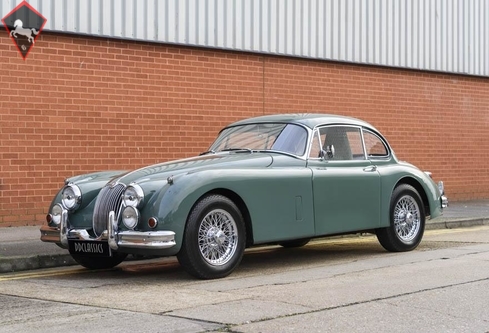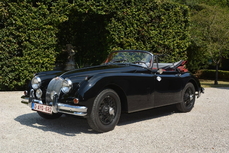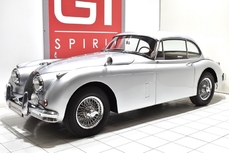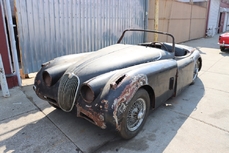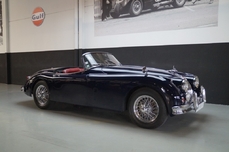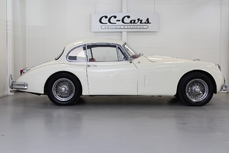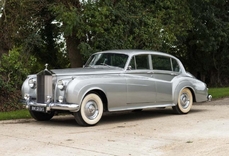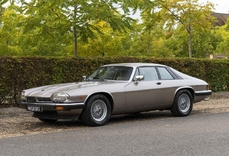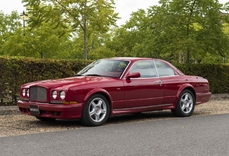Jaguar XK150 FHC 3.8 (RHD) 3.8 1959
General description :
Tastefully upgraded and restored
Finished in stunning Sherwood Green over Suede Green leather
Engine bored out from 3.4 to 3.8 Litre
5-Speed Gearbox
Alloy Radiator
Uprated brakes
A truly lovely, thoroughly usable example
2 sets of seats
Wood-rim steering wheel
Walnut wood dash
1959 Jaguar XK150 FHC 3.8 (RHD)
The stunning Jaguar XK150 we are proud to offer you today is a tastefully uprated example and far improved over a standard XK150. Finished in the truly stunning colour combination of Sherwood Green paintwork over Suede Green Leather interior with the elegant addition of a Burr Walnut dash, giving the interior a far warmer feel. The car has been tastefully uprated over the years with many great features from a Nardi steering wheel and inertia rear seatbelts to more significant mechanical upgrades, the main being the engine which was bored out from 3.4 to 3.8 Litres. It also benefits from a 5-Speed Manual Gearbox, new alternator, Zeus 4-pot front calipers, stainless steel sports exhaust system, large capacity radiator, Kenlowe fan and Gaz Shocks. It sits on desirable MWS Chrome Wire Wheels whilst the driver sits on beautifully trimmed, modern Mazda MX5 seats in the lovely suede green, making the car far more comfortable whilst still retaining its looks. Also included are the original front seats and the original wire wheels.
You would truly struggle to find such a lovely example in such desirable colours, let alone one that has been so tastefully improved, making for a truly wonderful driver’s car with capabilities beyond the standard XK150. If you’re looking what’s both lovely cosmetically and a really usable example of the iconic Jaguar XK150, look no further.
The XK150 was the third and final stage in the evolution of the XK which was the first of the post-war ‘big cats’ and launched in 1948 at the London Motor Show with a production run spanning 12 years, 3 variations, XK 120, XK140 and XK150. The 150 was launched in May 1957, initially with a choice of fixed head and drophead coupé bodies. The open two-seater followed a little later, and was at first available only as left-hand drive for export, with most of these cars going to the USA.
The styling of the XK150 was modernised, and if the car had lost some of the lithe grace that had characterised the first and purest version of the XK design, it had clearly become more muscular. There were other worthwhile improvements. Although a ‘standard’ XK150 with disc wheels and drum brakes was quoted in the catalogue, it is believed that virtually all production cars were of the ‘Special Equipment’ model, which had wire wheels and four-wheel disc brakes.
Motor Sport magazine road test, October 1958:
“The excellence of the Jaguar is now proverbial and it was a pleasure to drive again behind the famous twin O.H.C. six-cylinder engine, which has won so many sports-car races for the Coventry manufacturer, while road-testing the latest XK150 coupe. There is no question but that the Jaguar provides very real high-speed performance, not only in respect of a maximum speed exceeding 125 m.p.h. but because roadholding, steering and braking are in keeping, Clubroom accounts of creditable journey times being no excuse for exaggeration where the driver of an XK150 is concerned. For an outlay of under £1,800 the purchaser of this latest addition to the twin-cam Jaguar family buys more safe speed and convenience than it is possible to obtain elsewhere. It can almost be said that the engine makes the car and the smooth flow of power from beneath the Jaguar bonnet is one of William Haynes’ greater achievements.”
Now available for viewing at the DD Classics Dealership in London, please call 0208 878 33 55 to book an appointment.
DISCLAIMER: The odometer figure listed is merely as it reads.
https://ddclassics.com/car-listing/jaguar-xk150-fhc-3-8-rhd/
1959 Jaguar XK150 FHC 3.8 (RHD) 3.8 is listed sold on ClassicDigest in Surrey by DD Classics for £76950.
Car Facts
Car type : Car Make : Jaguar Model : XK150 Model Version : FHC 3.8 (RHD) 3.8 Engine size : 3.8 Model Year : 1959 Sub type : Race/Rally Car Location : Surrey
Sold
Seller Information
Sold
People who viewed this Jaguar XK150 also viewed similar Jaguar listed at ClassicDigest
Other cars listed for sale by this dealer
About Jaguar
Ah, the story of Jaguar, from its early days as the SS Cars Ltd. to its pinnacle with the D-type, and the street-going evolution in the form of the iconic E-type. There's something quintessentially British about this tale, and I'll narrate it as a British journalist might.In the Beginnings:
Our journey into the world of Jaguar begins in the 1930s, when a company known as SS Cars Ltd. emerged. Despite the unfortunate coincidence of their initials with the rising political tensions in Europe, they started producing stylish and performance-oriented cars. The SS 100, introduced in 1936, was a symbol of elegance and speed, setting the stage for what would become Jaguar.
The Birth of Jaguar:
As the shadows of World War II loomed, SS Cars Ltd. wisely decided to disassociate themselves from the SS initials. Thus, in 1945, they officially became Jaguar Cars Ltd., a name that would soon be synonymous with British luxury and performance.
The XK Series:
Jaguar's post-war era brought us the XK 120, a true sensation in 1948. With its sleek design and a powerful 3.4-liter inline-six engine, it became the world's fastest production car. The XK 120 was the blueprint for what lay ahead – Jaguars that blended style with speed in a uniquely British fashion.
The D-type Dominance:
Then came the D-type, a true racing legend. Introduced in 1954, it won Le Mans three times in the 1950s, showcasing Jaguar's engineering prowess. With its innovative monocoque construction and the iconic fin at the back, the D-type was the apex of Jaguar's motorsport success.
The E-type Emergence:
But the true turning point arrived in 1961 with the introduction of the E-type, often described by Enzo Ferrari as "the most beautiful car ever made." Its long bonnet, curvaceous body, and a 3.8-liter engine delivering exhilarating performance made it an instant classic. The E-type was not just a car; it was a work of art on wheels, and it could hit 150 mph on the road.
Street and Racing Success:
The E-type's beauty was matched by its capability on the track. The lightweight E-types were particularly successful in various racing events, cementing Jaguar's reputation as a force to be reckoned with in motorsport.
The Age of Refinement:
As we delve deeper into the Jaguar story, we find that the 1950s and 1960s were an age of refinement and expansion. Alongside the magnificent D-type and the E-type's iconic emergence, Jaguar introduced models that further solidified its reputation for luxury and performance.
The MK2:
In the late 1950s, Jaguar unveiled the MK2, a sports sedan that combined elegance with power. This sleek four-door saloon was a favorite of bank robbers and law enforcement alike, thanks to its exceptional speed and handling. The MK2 was a symbol of Jaguar's ability to blend sophistication with performance and had a successful racing career as well.
The XJ6:
Fast forward to 1968, and Jaguar launched a car that would define luxury saloons for decades to come – the XJ6. It was a masterpiece of engineering and design, featuring a smooth inline-six engine, independent rear suspension, and a spacious, beautifully appointed interior. The XJ6 was a symbol of British elegance and provided a ride so smooth that it seemed to glide over the road. It became the flagship model for Jaguar and set the standard for luxury saloons, showcasing a level of refinement that left competitors in awe.
The Blend of Classic and Modern:
While the MK2 and XJ6 represented the evolution of Jaguar's saloon cars, they maintained the brand's commitment to performance and luxury. These cars didn't just belong on the racetrack; they were equally at home cruising down the grand boulevards or gliding through the English countryside.
The Challenges of Change:
However, as the 1970s arrived, Jaguar, like many British automakers, faced financial challenges and changes in ownership. The British Leyland era brought both opportunities and struggles, as the brand navigated through various mergers and transitions.
Nevertheless, the legacy of the MK2 and XJ6, along with the D-type and E-type, continues to define Jaguar as a manufacturer that combines timeless elegance with a spirit of performance. These classic models, whether driven on winding roads or parked as collectors' treasures, serve as a testament to Jaguar's enduring presence in the world of automotive excellence.
The Jaguar story, from its early days as SS Cars Ltd. to the creation of automotive icons like the E-type, MK2, and XJ6, is a journey that reflects the very essence of British motoring – a blend of luxury, power, and style that continues to captivate enthusiasts and connoisseurs alike.
